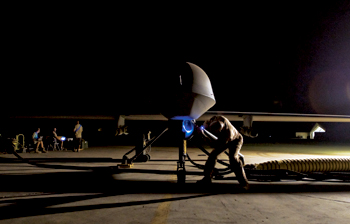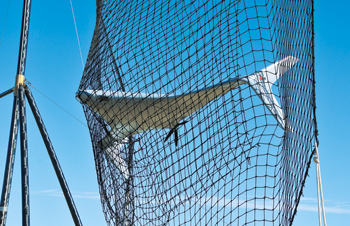INDIAN ARMED FORCES CHIEFS ON OUR RELENTLESS AND FOCUSED PUBLISHING EFFORTS

SP Guide Publications puts forth a well compiled articulation of issues, pursuits and accomplishments of the Indian Army, over the years

"Over the past 60 years, the growth of SP Guide Publications has mirrored the rising stature of Indian Navy. Its well-researched and informative magazines on Defence and Aerospace sector have served to shape an educated opinion of our military personnel, policy makers and the public alike. I wish SP's Publication team continued success, fair winds and following seas in all future endeavour!"

Since, its inception in 1964, SP Guide Publications has consistently demonstrated commitment to high-quality journalism in the aerospace and defence sectors, earning a well-deserved reputation as Asia's largest media house in this domain. I wish SP Guide Publications continued success in its pursuit of excellence.
Drone Syndrome
The concern is not so much about UAV technologies but the proliferation of UAVs in the near future as they become cheaper and lot more accessible


The skies are soon going to be dotted by unmanned aerial vehicles (UAVs) also known as drones. And that is certainly going to be a problem, if left unregulated. While Jeff Bezos of Amazon wants to use drones to deliver products to online retail consumers, the military has gone beyond reconnaissance and surveillance to more lethal roles. The future is scary. According to aerospace consultancy firm Teal, in about a decade’s time, there are going to be over 32,000 commercial drones flying worldwide, delivering goods, medical supplies, disaster relief and whatever the little drone can hold. As UAV technologies get better, it is just about disrupting the skies and regulators are in a bind as to how to deal with the new toy in the hands of kids, businesses and the military and not to forget disruptive elements. The US Federal Aviation Administration (FAA) which has guidelines for drone flying is proposing regulations and so are other countries. The concern is not so much about UAV technologies but the proliferation of UAVs in the near future as they become cheaper and lot more accessible. They are going to be toys for kids, business tool for others and lethal weapons for some. It is a real concern. In this background, let us look at the UAV technologies that are playing out.



It all began, as per media reports, with the US Defense Advanced Research Projects Agency (DARPA) launching ‘Teal Rain’, a top-secret study on high altitude, long endurance unmanned aircraft in 1980. And in the year of George Orwell’s 1984, DARPA contracted with Abe Karem’s company Leading Systems (which later was acquired by General Atomics) to design a drone called ‘Amber’, rechristened as ‘Gnat’ and sold to the Central Intelligence Agency (CIA). A few years later, General Atomics gets a contract to develop the ‘Predator’.
The Predator
That name spells it all. Conceived in the early 1990s for aerial reconnaissance and forward observation roles, the Predator carries cameras and other sensors, but has now been upgraded to carry and fire two AGM-114 Hellfire missiles or other munitions. The drone has seen combat over Afghanistan, Pakistan, Bosnia, Serbia, Iraq, Yemen, Libya, Syria and Somalia. The US Air Force describes the Predator as a ‘Tier-II’ medium altitude, long endurance (MALE) UAV. The UAV consists of four air vehicles with sensors, a ground control station and a primary satellite link communication suite. The UAV can fly up to 400 nautical miles to a target, loiter overhead for 14 hours, then return to its base.
It was in early 2000, the RQ-1 Predator was deployed for offensive operations in Afghanistan and Pakistan. The Predator has become the iconic image of drone warfare. The US Air Force (USAF) and the CIA are using an updated version of the Predator, the Reaper. There is continuous research going on to make the UAVs lot more stealthier, lot more lethal, lot more enduring, lot more effective. Soon drones will be able to penetrate air defences and may be even kill terrorists from high altitudes. If it falls in the hands of terrorists, it can be disastrous.
nEUROn Spells Danger

It is a European programme for an unmanned combat air vehicle (UCAV) technology demonstrator from the stables of Dassault Aviation. The nEUROn programme is designed to validate the development of complex technologies representing all mission systems: high-level flight control and stealth; launching real air-to-ground weapons from an internal bay; integrating in the C4I environment, etc. The demonstrator had its first flight on December 1, 2012.
In February this year, the nEUROn demonstrator completed its testing campaign. The purpose of the tests was to open the flight envelope to test the electro-optical sensor; evaluate data link performance; electromagnetic signature/detection confrontations against operational systems. Dassault has reported successful completion of the tests and the nEUROn evaluations will now take place in Italy and Sweden.
Solo, the Smart Drone



3D Robotics has Solo, said to be the world’s smartest drone and the company calls it the first drone with a brain. Solo is powered by twin one Ghz computers and it is the only drone to stream live HD video from GoPro direct to iOS/Android devices at ranges up to half a kilometre. It takes to the air in seconds with effortless pushbutton flight. It has powerful Smart Shot technology which makes capturing incredible cinematic footage easy and automatic.
The Solo Gimbal delivers smooth footage, GoPro power and control and HDMI video and the future-proof accessory and gimbal bays make Solo ready for tomorrow’s technology. The company states that when it set out to create the best drone, it also wanted to create the best aerial photography experience imaginable.
What makes Solo smart? The Solo has the world’s most advanced Pixhawk 2 autopilot system and one of the computers is on the copter, while the other is in the controller, connected via a powerful dedicated Wi-Fi signal carried by 3DR link. This processing power enables Solo to do amazing things that no personal drone has ever been able to do, claims 3DR. The company states that the Solo is built to evolve: gimbal bay, accessory bay and swappable motor pods for easily integrating new technology and features as they are invented, so the technology does not get obsolete fast.
Cicada in Your Palm
The US Navy’s new Cicada (close-in covert autonomous disposable aircraft) UAV is so small that it fits in the palm of one’s hand. The Cicada drones are equipped with sensors to monitor weather and atmospheric details and also to detect dangerous substances such as chemical weapons. The Cicadas do not have motors or engines, but are guided by a circuit board with preprogramme GPS coordinates.
The Cicada drone has a speed of about 75 km per hour and are almost silent, with no engine or propulsion system and the US Naval Research Laboratory is trying to bring its cost down to $250 from around $1,000 now. The idea behind its tiny size, according to a spokesperson of the lab, is that to deploy as many Cicadas as possible, making it difficult for the enemy to pick them all up. Bombarding with Cicadas appears to be a good strategy. The UAVs could be outfitted with magnetic sensors to pick up enemy submarines or to eavesdrop. These can also be thrown from an aircraft as to let it over the region that needs surveillance or reconnaissance.
Little Bird H-6U
Boeing’s new Little Bird H-6U is the unmanned variant of the AH-6i manned scout helicopter. Its unique design combines the autonomous flight capability, networked payloads and communications of an UAV with a combat-proven rotorcraft platform. Autopilot is a common feature on most major civilian and military fixed-wing airplanes, but it is very rare to find on vertical lift aircraft. Thanks to a kit Boeing is developing for the Little Bird, hundreds of rotorcraft could eventually be capable of flying unmanned. “Unmanned Little Bird isn’t about the platform. It is about the unmanned capability. It’s about the UAV kit. It’s about putting unmanned or optionally piloted capability in any vertical lift aircraft,” said Mike Sahag, Business Development Lead for the Little Bird.
Nano Hummingbird
AeroVironment developed the Nano Air Vehicle (NAV) under a DARPA sponsored research contract to develop a new class of UAVs capable of indoor and outdoor operation. Employing biological mimicry at an extremely small scale, this UAV provides reconnaissance and surveillance capabilities in urban environment. The technical milestone it has achieved includes controlled precision hovering and fast-forward flight of a twowing, flapping wing aircraft that carries its own energy sources and uses only the flapping wings for propulsion and control.
‘Nano Hummingbird’ is capable of climbing and descending vertically, flying sideways, flying forward and backward and rotating clockwise and counter-clockwise. AeroVironment’s Senior Vice President and General Manager of UAS states: “From the battle-proven Raven, Wasp and Puma small UAS to the tiny Nano Hummingbird to Global Observer, the largest, highest and longest flying UAS, AeroVironment continues to define the future of unmanned aircraft systems.”
Widely Used Raven
The Raven is the most widely used unmanned aircraft system in the world today. The Raven B DDL system, an enhanced version of the battle proven Raven B system, is a lightweight solution designed for rapid deployment and high mobility for military applications requiring low-altitude surveillance and reconnaissance intelligence.
The Raven can be operated manually or programmed for autonomous operation, utilising the system’s advanced avionics and precise GPS navigation. With a wingspan of 4.5 feet and a weight of 4.2 pounds, the hand-launched Raven provides aerial observation, day or night, at line-of-sight ranges up to 10 kilometres. The Raven, now available with an optional stabilised gimbaled payload, delivers real-time colour or infrared imagery to the ground control and remote viewing stations. AeroVironment’s common GCS interfaces with all of its tactical ISR air vehicles reducing the level of training required and decreasing the time and cost involved.
Zephyr, Running on Solar Power
It is a high altitude pseudo satellite (HAPS) UAV, running on solar power. Originally designed and built by QinetiQ and now part of the Airbus HAPS programme, Zephyr endures like a satellite, focuses like an aircraft and is said to be cheaper than both. Zephyr holds currently the ‘Endurance World Record’ having been airborne for over 14 days. The next generation Zephyrs will be able to carry much more payload and can be used for maritime and border surveillance; environmental surveillance; in-theatre C4ISTAR relay and missile detection. Zephyr fills a capability gap between satellites and UAVs.
Bat, Self-Contained Expeditionary UAV
Bat is Northrop Grumman’s family of affordable, medium altitude, multi-mission unmanned aircraft systems. This product line can be configured with differently-sized fuel tanks and different sensor payloads to meet ever-changing tactical missions, including intelligence, surveillance, reconnaissance, target acquisition and communications relay. Additionally, the Bat has a blended body design, enabling a much larger payload volume (3.2 cubic feet) that allows it to carry more payload than other UAVs of its size.
Currently the Bat family product line features either the 10 or 12 foot-wingspan variant, with a 20-foot wingspan design under development. Under the command and control of its scalable, IP-based ground control station, Northrop Grumman has successfully flown multiple payloads on multiple flights with both the 10 and 12-foot Bats. Also from Northrop Grumman stable is the RQ-180, designed to fly very high and for a very long time.
Lockheed Martin’s SR-72
Lockheed Martin is developing an unmanned hypersonic spy plane funded by NASA, called the SR-72, expected to fly at speeds of Mach 6.0 or 7,200 kmph, double the speed of the Lockheed SR-71 Blackbird. The twin-engine UAV would not be ready to fly until 2030.
In the ultimate analysis, while technology is outpacing itself, the proliferation of drones is going to be on everyone’s mind. Paris-based Parrot, top maker of consumer drones, has said it has shipped over 7,50,000 drones since its first quadcopter in 2010. It expects to sell about 2,00,000 this year. The sky is the limit.





